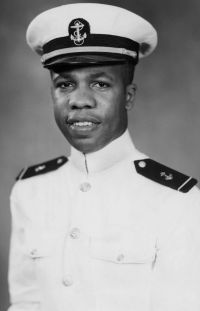 In honor of Black History Month and in light of current events, it seems especially worthwhile to remember the pioneering career of Wesley A. Brown, who endured intense racial harassment to become the first black graduate of the United States Naval Academy in 1949.
In honor of Black History Month and in light of current events, it seems especially worthwhile to remember the pioneering career of Wesley A. Brown, who endured intense racial harassment to become the first black graduate of the United States Naval Academy in 1949.
Wesley Brown entered the Naval Academy in 1945 as the sixth black man admitted in the 100-year history of the Annapolis military college. He was the first to successfully withstand the intense racism that had forced the others to leave within a year, according to Navy historians.
The New York Times recounted that white midshipmen refused to sit next to Mr. Brown, racial epithets were whispered behind his back, and fellow plebes barred him from joining the choir — all of it mixed with and hidden behind a torrent of regular hazing that underclassmen were expected to bear. He told interviewers that not a day passed when he did not consider quitting.
But unlike his predecessors, he said, Mr. Brown had the support of a handful of fellow midshipmen, who were friendly to him despite receiving threats from hostile classmates, and from the academy commandant, who intervened to protect him from excessive harassment.
One midshipman who visited his dorm room to talk and encouraged him to “hang in there,” Mr. Brown said, was the son of a peanut farmer from Plains, Georgia, who was then an upperclassman and fellow member of the academy’s cross-country team. The midshipman’s name was Jimmy Carter, the future president of the United States.
In a speech last year at a Naval Academy event, Mr. Carter recalled Midshipman Brown.
“My first personal experience with racial integration began when an African American student, Wesley Brown, entered the U.S. Naval Academy in 1945. We both ran cross-country during the year that we spent together in Annapolis. A few members of my senior class attempted to find ways to have him discharged, but Brown’s good performance prevailed and he became the Academy’s first black graduate…”
After graduating from the Naval Academy, Brown served in the Korean and Vietnam Wars. In the Navy’s Civil Engineering Corps he worked on Navy construction projects around the world. He built houses in Hawaii, roads in Liberia, wharves in the Philippines, a nuclear power plant in Antarctica, and a desalination plant in Cuba, before retiring as a lieutenant commander in 1969. He was a facilities manager and planner at Howard University in Washington until 1988.
Wesley Brown died of cancer in 2012 at the age of 85.
In 2008, the Naval Academy dedicated a new facility for athletic programs, the Wesley Brown Field House in his honor. The $25 million structure was built with many innovative features, academy officials said, including a skinlike shell made from blastproof glass.
Throughout his life, Wesley Brown loyally attended class reunions. In a 2006 interview with The Baltimore Sun, he described former classmates who sometimes approached him. “They’ll say, ‘I was very mean and ugly to you when you were a midshipman,’ ” he said. “Lots of times I’ll say, ‘I don’t remember you and don’t remember you doing anything like that, so forget it.’ ”
He added: “You remember the good stuff. A lot of the bad stuff — I can’t relate to it.”
Thanks to Andrew Reinbach for contributing to this post.

Thanks very much for including Wesley Brown in your Black History Month coverage. He was a friends of my parents and had dinner at our house quite a bit, including Seders. My father insisted we only call him Mr. Brown.
I;m a retired journalist, and about 20 years ago, I called Mr. Brown with the idea of writing his biography. He turned me down, though, when I told him I wanted to write about the pervasive racism he faced in the Navy, telling me “I only want to think about the good things.”
The man was a giant. It was Mr. Brown who paved the way for Colin Powell and all the senior Black officers, and Chairmen of the Joint Chiefs, who followed him. He should have made admiral, and would have, if he hadn’t been who he was.
Thanks for pointing him out to me. He was an admirable gentleman.